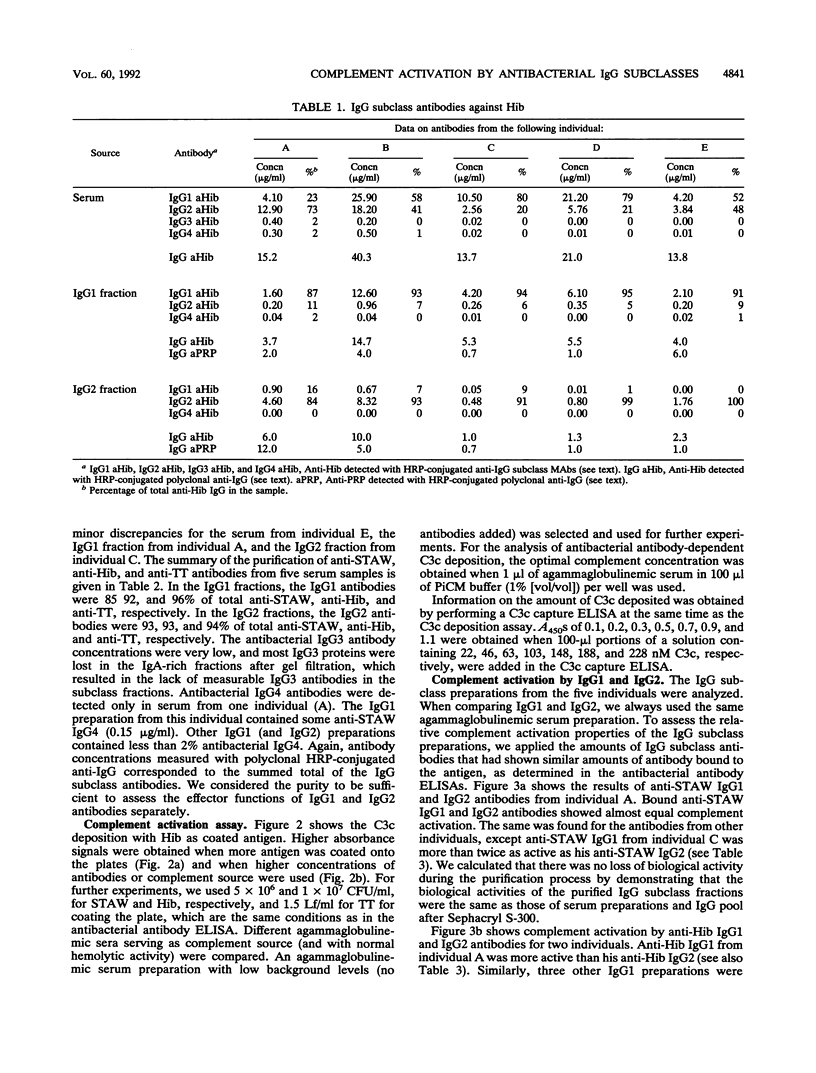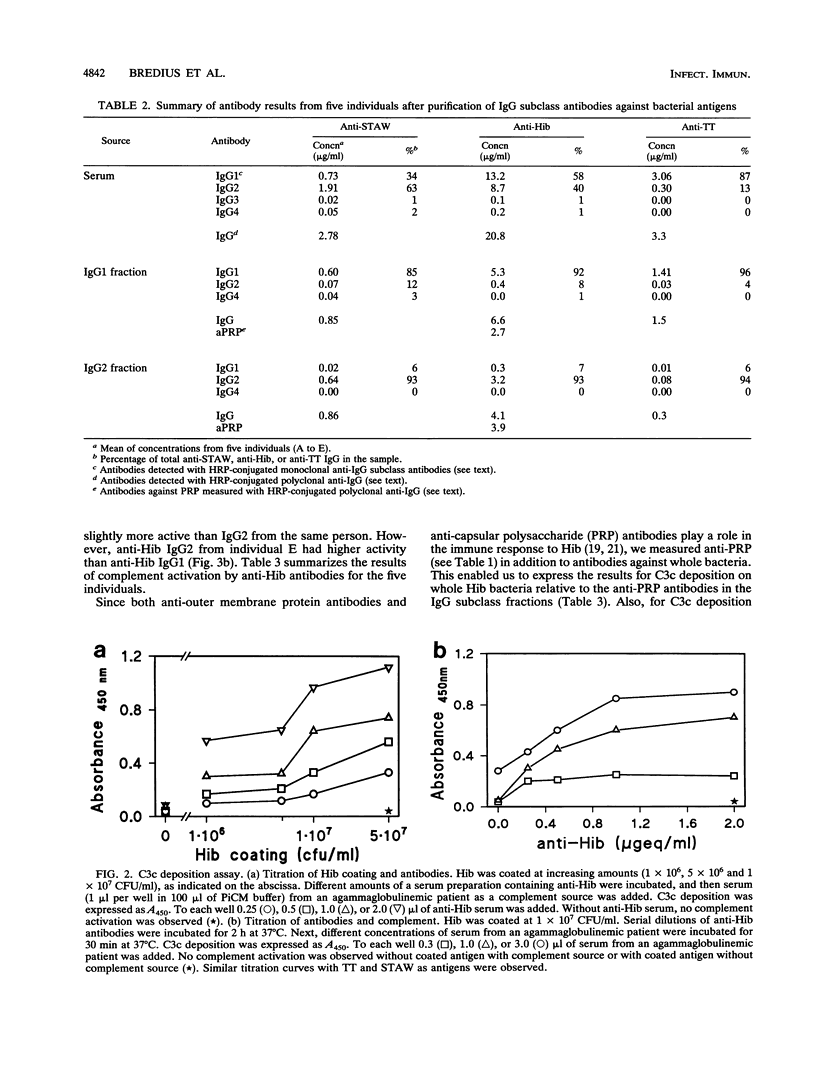Abstract
To obtain information on effector functions of human immunoglobulin G2 (IgG2), we have measured the complement-activating properties of polyclonal IgG subclass antibodies against bacterial antigens. IgG1 and IgG2 were purified from serum samples from five healthy individuals, and complement activation was measured with different bacterial antigens. We used Staphylococcus aureus Wood 46 (STAW), which is a common antigen, Haemophilus influenzae type b (Hib), which is a common pathogenic microorganism in children, and formaldehyde-inactivated tetanus toxin (TT). Bacteria were incubated with antibodies and then incubated with sera from agammaglobulinemic patients as a complement source, and C3c deposition was measured by enzyme-linked immunosorbent assay. We found that anti-STAW IgG2 activated complement to a level similar to that of anti-STAW IgG1. Anti-Hib IgG1 complement activation was as much as seven times higher than that of anti-Hib IgG2 in four individuals. In one individual, anti-Hib IgG2 was more effective in complement activation than anti-Hib IgG1. Anti-TT antibodies showed patterns similar to those of anti-Hib. Our results indicate that IgG2 antibodies may contribute significantly to antibacterial defense. Also, individual differences in antibody effector functions should be taken into account when evaluating the immune status of patients and during early phase 1 studies of new vaccines.
Full text
PDF









Selected References
These references are in PubMed. This may not be the complete list of references from this article.
- Amir J., Liang X., Granoff D. M. Variability in the functional activity of vaccine-induced antibody to Haemophilus influenzae type b. Pediatr Res. 1990 Apr;27(4 Pt 1):358–364. doi: 10.1203/00006450-199004000-00008. [DOI] [PubMed] [Google Scholar]
- Amir J., Scott M. G., Nahm M. H., Granoff D. M. Bactericidal and opsonic activity of IgG1 and IgG2 anticapsular antibodies to Haemophilus influenzae type b. J Infect Dis. 1990 Jul;162(1):163–171. doi: 10.1093/infdis/162.1.163. [DOI] [PubMed] [Google Scholar]
- Anthony B. F., Concepcion N. F., McGeary S. A., Ward J. I., Heiner D. C., Shapshak P., Insel R. A. Immunospecificity and quantitation of an enzyme-linked immunosorbent assay for group B streptococcal antibody. J Clin Microbiol. 1982 Aug;16(2):350–354. doi: 10.1128/jcm.16.2.350-354.1982. [DOI] [PMC free article] [PubMed] [Google Scholar]
- Blank S. E., Leslie G. A., Clem L. W. Antibody affinity and valence in viral neutralization. J Immunol. 1972 Mar;108(3):665–673. [PubMed] [Google Scholar]
- Brüggemann M., Williams G. T., Bindon C. I., Clark M. R., Walker M. R., Jefferis R., Waldmann H., Neuberger M. S. Comparison of the effector functions of human immunoglobulins using a matched set of chimeric antibodies. J Exp Med. 1987 Nov 1;166(5):1351–1361. doi: 10.1084/jem.166.5.1351. [DOI] [PMC free article] [PubMed] [Google Scholar]
- Burton D. R. Immunoglobulin G: functional sites. Mol Immunol. 1985 Mar;22(3):161–206. doi: 10.1016/0161-5890(85)90151-8. [DOI] [PubMed] [Google Scholar]
- Cates K. L., Marsh K. H., Granoff D. M. Serum opsonic activity after immunization of adults with Haemophilus influenzae type b-diphtheria toxoid conjugate vaccine. Infect Immun. 1985 Apr;48(1):183–189. doi: 10.1128/iai.48.1.183-189.1985. [DOI] [PMC free article] [PubMed] [Google Scholar]
- Dangl J. L., Wensel T. G., Morrison S. L., Stryer L., Herzenberg L. A., Oi V. T. Segmental flexibility and complement fixation of genetically engineered chimeric human, rabbit and mouse antibodies. EMBO J. 1988 Jul;7(7):1989–1994. doi: 10.1002/j.1460-2075.1988.tb03037.x. [DOI] [PMC free article] [PubMed] [Google Scholar]
- Duhamel R. C., Schur P. H., Brendel K., Meezan E. pH gradient elution of human IgG1, IgG2 and IgG4 from protein A-sepharose. J Immunol Methods. 1979;31(3-4):211–217. doi: 10.1016/0022-1759(79)90133-9. [DOI] [PubMed] [Google Scholar]
- EISEN H. N., SISKIND G. W. VARIATIONS IN AFFINITIES OF ANTIBODIES DURING THE IMMUNE RESPONSE. Biochemistry. 1964 Jul;3:996–1008. doi: 10.1021/bi00895a027. [DOI] [PubMed] [Google Scholar]
- Eichler I., Joris L., Hsu Y. P., Van Wye J., Bram R., Moss R. Nonopsonic antibodies in cystic fibrosis. Pseudomonas aeruginosa lipopolysaccharide-specific immunoglobulin G antibodies from infected patient sera inhibit neutrophil oxidative responses. J Clin Invest. 1989 Dec;84(6):1794–1804. doi: 10.1172/JCI114364. [DOI] [PMC free article] [PubMed] [Google Scholar]
- Engels W., Endert J., Van Boven C. P. A quantitative method for assessing the third complement factor (C3) attached to the surface of opsonized Pseudomonas aeruginosa: interrelationship between C3 fixation, phagocytosis and complement consumption. J Immunol Methods. 1985 Jul 16;81(1):43–53. doi: 10.1016/0022-1759(85)90120-6. [DOI] [PubMed] [Google Scholar]
- Fauci A. S., Frank M. M., Johnson J. S. The relationship between antibody affinity and the efficiency of complement fixation. J Immunol. 1970 Jul;105(1):215–220. [PubMed] [Google Scholar]
- Garred P., Michaelsen T. E., Aase A. The IgG subclass pattern of complement activation depends on epitope density and antibody and complement concentration. Scand J Immunol. 1989 Sep;30(3):379–382. doi: 10.1111/j.1365-3083.1989.tb01225.x. [DOI] [PubMed] [Google Scholar]
- Givner L. B., Baker C. J., Edwards M. S. Type III group B Streptococcus: functional interaction with IgG subclass antibodies. J Infect Dis. 1987 Mar;155(3):532–539. doi: 10.1093/infdis/155.3.532. [DOI] [PubMed] [Google Scholar]
- Gordon D. L., Rice J., Finlay-Jones J. J., McDonald P. J., Hostetter M. K. Analysis of C3 deposition and degradation on bacterial surfaces after opsonization. J Infect Dis. 1988 Apr;157(4):697–704. doi: 10.1093/infdis/157.4.697. [DOI] [PubMed] [Google Scholar]
- Griswold W. R., Lucas A. H., Bastian J. F., Garcia G. Functional affinity of antibody to the Haemophilus influenzae type b polysaccharide. J Infect Dis. 1989 Jun;159(6):1083–1087. doi: 10.1093/infdis/159.6.1083. [DOI] [PubMed] [Google Scholar]
- Habeeb A. F., Francis R. D. Preparation of human immunoglobulin by caprylic acid precipitation. Prep Biochem. 1984;14(1):1–17. doi: 10.1080/10826068408070610. [DOI] [PubMed] [Google Scholar]
- Hetherington S. V. Antibody to the outer membrane proteins is the dominant opsonic antibody in normal human serum against H. influenzae type b. Immunology. 1989 May;67(1):87–91. [PMC free article] [PubMed] [Google Scholar]
- Hetherington S. V., Lepow M. L. Correlation between antibody affinity and serum bactericidal activity in infants. J Infect Dis. 1992 Apr;165(4):753–756. doi: 10.1093/infdis/165.4.753. [DOI] [PubMed] [Google Scholar]
- Hetherington S. V., Patrick C. C. Complement component 3 binding to Haemophilus influenzae type b in the presence of anticapsular and anti-outer membrane antibodies. Infect Immun. 1992 Jan;60(1):19–24. doi: 10.1128/iai.60.1.19-24.1992. [DOI] [PMC free article] [PubMed] [Google Scholar]
- Hugo F., Krämer S., Bhakdi S. Sensitive ELISA for quantitating the terminal membrane C5b-9 and fluid-phase SC5b-9 complex of human complement. J Immunol Methods. 1987 May 20;99(2):243–251. doi: 10.1016/0022-1759(87)90134-7. [DOI] [PubMed] [Google Scholar]
- Ishizaka T., Ishizaka K., Salmon S., Fudenberg H. Biologic activities of aggregated gamma-globulin. 8. Aggregated immunoglobulins of different classes. J Immunol. 1967 Jul;99(1):82–91. [PubMed] [Google Scholar]
- Jefferis R., Reimer C. B., Skvaril F., de Lange G. G., Goodall D. M., Bentley T. L., Phillips D. J., Vlug A., Harada S., Radl J. Evaluation of monoclonal antibodies having specificity for human IgG subclasses: results of the 2nd IUIS/WHO collaborative study. Immunol Lett. 1992 Feb;31(2):143–168. doi: 10.1016/0165-2478(92)90141-a. [DOI] [PubMed] [Google Scholar]
- Lugtenberg B., Van Alphen L. Molecular architecture and functioning of the outer membrane of Escherichia coli and other gram-negative bacteria. Biochim Biophys Acta. 1983 Mar 21;737(1):51–115. doi: 10.1016/0304-4157(83)90014-x. [DOI] [PubMed] [Google Scholar]
- Michaelsen T. E., Garred P., Aase A. Human IgG subclass pattern of inducing complement-mediated cytolysis depends on antigen concentration and to a lesser extent on epitope patchiness, antibody affinity and complement concentration. Eur J Immunol. 1991 Jan;21(1):11–16. doi: 10.1002/eji.1830210103. [DOI] [PubMed] [Google Scholar]
- Nagelkerken L. M., van Zoonen-van Exel M., van Walbeek H. K., Aalberse R. C., Out T. A. Analysis of cerebrospinal fluid and serum of patients with multiple sclerosis by means of anti-idiotypic antisera. J Immunol. 1982 Mar;128(3):1102–1106. [PubMed] [Google Scholar]
- Out T. A., van de Graaf E. A., van den Berg N. J., Jansen H. M. IgG subclasses in bronchoalveolar lavage fluid from patients with asthma. Scand J Immunol. 1991 Jun;33(6):719–727. doi: 10.1111/j.1365-3083.1991.tb02546.x. [DOI] [PubMed] [Google Scholar]
- Oxelius V. A. Immunoglobulin G (IgG) subclasses and human disease. Am J Med. 1984 Mar 30;76(3A):7–18. doi: 10.1016/0002-9343(84)90314-0. [DOI] [PubMed] [Google Scholar]
- Persson M. A., Brown S. E., Steward M. W., Hammarström L., Smith C. I., Howard C. R., Wahl M., Rynnel-Dagö B., Lefranc G., Carbonara A. O. IgG subclass-associated affinity differences of specific antibodies in humans. J Immunol. 1988 Jun 1;140(11):3875–3879. [PubMed] [Google Scholar]
- Rautonen N., Seppälä I., Hallberg T., Grubb R., Mäkelä O. Determination of homozygosity or heterozygosity for the G2m(n) allotype by a monoclonal, precipitating antibody. Exp Clin Immunogenet. 1989;6(1):31–38. [PubMed] [Google Scholar]
- Ruths S., Driedijk P. C., Weening R. S., Out T. A. ELISA procedures for the measurement of IgG subclass antibodies to bacterial antigens. J Immunol Methods. 1991 Jun 24;140(1):67–78. doi: 10.1016/0022-1759(91)90127-2. [DOI] [PubMed] [Google Scholar]
- Schumaker V. N., Calcott M. A., Spiegelberg H. L., Müller-Eberhard H. J. Ultracentifuge studies of the binding of IgG of different subclasses to the Clq subunit of the first component of complement. Biochemistry. 1976 Nov 16;15(23):5175–5181. doi: 10.1021/bi00668a035. [DOI] [PubMed] [Google Scholar]
- Schur P. H., Borel H., Gelfand E. W., Alper C. A., Rosen F. S. Selective gamma-g globulin deficiencies in patients with recurrent pyogenic infections. N Engl J Med. 1970 Sep 17;283(12):631–634. doi: 10.1056/NEJM197009172831205. [DOI] [PubMed] [Google Scholar]
- Sennhauser F. H., Balloch A., Macdonald R. A., Shelton M. J., Roberton D. M. Maternofetal transfer of IgG anti-Escherichia coli antibodies with enhanced avidity and opsonic activity in very premature neonates. Pediatr Res. 1990 Apr;27(4 Pt 1):365–371. doi: 10.1203/00006450-199004000-00009. [DOI] [PubMed] [Google Scholar]
- Shackelford P. G., Polmar S. H., Mayus J. L., Johnson W. L., Corry J. M., Nahm M. H. Spectrum of IgG2 subclass deficiency in children with recurrent infections: prospective study. J Pediatr. 1986 May;108(5 Pt 1):647–653. doi: 10.1016/s0022-3476(86)81035-6. [DOI] [PubMed] [Google Scholar]
- Tan L. K., Shopes R. J., Oi V. T., Morrison S. L. Influence of the hinge region on complement activation, C1q binding, and segmental flexibility in chimeric human immunoglobulins. Proc Natl Acad Sci U S A. 1990 Jan;87(1):162–166. doi: 10.1073/pnas.87.1.162. [DOI] [PMC free article] [PubMed] [Google Scholar]
- Ward J. I., Greenberg D. P., Anderson P. W., Burkart K. S., Christenson P. D., Gordon L. K., Kayhty H., Kuo J. S., Vella P. Variable quantitation of Haemophilus influenzae type b anticapsular antibody by radioantigen binding assay. J Clin Microbiol. 1988 Jan;26(1):72–78. doi: 10.1128/jcm.26.1.72-78.1988. [DOI] [PMC free article] [PubMed] [Google Scholar]
- Weinberg G. A., Granoff D. M., Nahm M. H., Shackelford P. G. Functional activity of different IgG subclass antibodies against type b capsular polysaccharide of Haemophilus influenzae. J Immunol. 1986 Jun 1;136(11):4232–4236. [PubMed] [Google Scholar]
- Whicher J. T., Higginson J., Riches P. G., Radford S. Clinical applications of immunofixation: detection and quantitation of complement activation. J Clin Pathol. 1980 Aug;33(8):781–785. doi: 10.1136/jcp.33.8.781. [DOI] [PMC free article] [PubMed] [Google Scholar]
- van Alphen L., Geelen L., Jónsdóttir K., Takala A. K., Käyhty H., Zanen H. C. Distinct geographic distribution of subtypes of Haemophilus influenzae type b in Western Europe. J Infect Dis. 1987 Jul;156(1):216–218. doi: 10.1093/infdis/156.1.216. [DOI] [PubMed] [Google Scholar]
- van de Graaf E. A., Jansen H. M., Bakker M. M., Alberts C., Eeftinck Schattenkerk J. K., Out T. A. ELISA of complement C3a in bronchoalveolar lavage fluid. J Immunol Methods. 1992 Mar 4;147(2):241–250. doi: 10.1016/s0022-1759(12)80014-7. [DOI] [PubMed] [Google Scholar]
- van der Zee J. S., van Swieten P., Aalberse R. C. Inhibition of complement activation by IgG4 antibodies. Clin Exp Immunol. 1986 May;64(2):415–422. [PMC free article] [PubMed] [Google Scholar]


